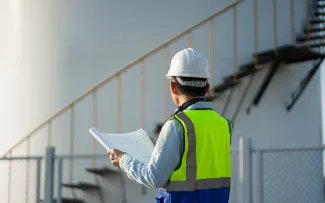
A few days before the school year was due to start back in September, over 100 schools in England were told to close due to serious health and safety concerns regarding reinforced autoclaved aerated concrete (RAAC) in buildings.
The material is less durable than concrete but had been used in local authority buildings across the country largely due to it being more cost-effective and easier to install.
The Health and Safety Executive (HSE) warned of significant safety consequences as a result of the material having an expired life span, with buildings liable to collapse with little or no notice.
Currently half of Scotland’s local authorities have identified RAAC in school buildings. We previously wrote about an employer’s responsibilities when navigating RAAC.
However, RAAC is not the first material used widespread in local authority buildings to raise health and safety concerns and become a focus of the HSE. The current RAAC situation in the UK draws stark similarities with that of asbestos.
The HSE has announced that it is carrying out a programme of inspections in primary and secondary schools across England, Scotland and Wales from October 2023. The purpose of the inspections is to assess how education sites are managing the risks from asbestos. It is noteworthy that during the 2022/23 cycle of inspections, enforcement action was taken against 7% of the schools inspected.
Asbestos in schools: a brief overview
Asbestos-containing materials were used extensively in the construction of schools and other public buildings from the 1950s until its use in Great Britain was banned in 1999.
In April 2023, it was reported that more than 1,700 schools in Scotland contained asbestos.
Asbestos is a fibrous material used in a variety of buildings due to its insulative properties and ability to protect against fire and corrosion. The fibres are carcinogenic meaning it can cause a range of respiratory disabilities, including lung cancer, and the HSE has reported that asbestos deaths are still in excess of 5,000 each year.
Asbestos will create a risk in schools when the asbestos is disturbed or damaged – that is typically as a result of maintenance, repair, or construction activities.
What are the statutory requirements for asbestos and who is responsible?
The Control of Asbestos Regulations 2012 came into effect on 6 April 2012 (and is supplemented by an Approved Code of Practice), revoking and replacing the Control of Asbestos Regulations 2006.
Regulation 4 obliges the ‘duty holder’ to manage the risk from asbestos in non-domestic premises and ensure that those working in affected buildings are kept safe from exposure to the material. The ‘duty holder’ is anyone responsible for maintenance and repairs and will usually be the employer.
Regulation 4 imposes an obligation to determine whether asbestos is present or is likely to be present and to manage any asbestos present or likely or be present. Duty holders are required to assess the risk and have an action plan and system in place for managing that risk. Failure to comply with the requirements constitutes a criminal offence.
Some practical guidance/requirements for sites that have asbestos-containing materials present include:
- An asbestos register;
- An asbestos management plan;
- Periodic monitoring of asbestos-containing material following an asbestos survey; and
- Effective communication (for example, with contractors attending the site).
The HSE has published an asbestos management checklist for schools, which is essential reading for those in the education sector dealing with asbestos-containing materials on their premises.
Asbestos inspections: what is the HSE doing now?
The HSE announced in September 2023 that it will be carrying out a programme of inspections to primary and secondary schools across England, Scotland and Wales from October 2023. It will be assessing how schools are managing the risks from asbestos materials within schools and meeting the statutory requirements.
The announcement is somewhat unsurprising given the risk of collapse of buildings and remediation activity related to RAAC possibly disturbing asbestos.
As HSE inspectors begin contacting schools to arrange these inspections there are a number of things you can do in preparation which include identifying the presence of asbestos in buildings, keeping a record of the location and condition of asbestos materials and implementing a management plan.
Historically, the HSE has enforced asbestos regulations rigorously and it seems as though this approach will continue. Prosecutions relating to breaches of the legislation this year have resulted in five-figure fines and prison sentences being imposed.
Getting ready for an HSE inspection
Being prepared for an inspection by the HSE is not only important in terms of not being caught out, but also in terms of the general management of the premises in order to keep everyone safe.
Where the HSE has identified non-compliance in the past, that has typically been because schools did not have up-to-date asbestos surveys and not having a clear and understandable management plan.
Some issues to consider, and which are also prudent in having a good document audit trail, include:
- An asbestos survey;
- Undertaking a risk assessment as regards the risk of asbestos at the premises;
- What is the management plan to mitigate any risks (and has the plan been reviewed)?; and
- Have staff been properly briefed (and trained) as regards the assessment of risk of asbestos?
If you or your business have any queries about asbestos obligations, please contact Kirsty MacCorquodale, a member of our Workplace Risk and Regulation team, or your usual Shepherd and Wedderburn contact.